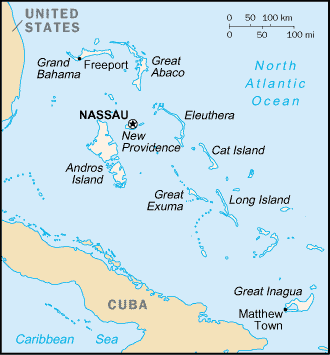6 Bahamas

Three equal horizontal bands of aquamarine (top), gold, and aquamarine, with a black equilateral triangle based on the hoist side. The band colors represent the golden beaches of the islands surrounded by the aquamarine sea. Black represents the vigor and force of a united people, while the pointing triangle indicates the enterprise and determination of the Bahamian people to develop the rich resources of land and sea.
Flag courtesy of the CIA World Factbook


The “wreck” of the Flying Dutchman, “marooned” at the resort island of Castaway Cay. According to folklore, the Flying Dutchman is a ghost ship doomed to sail the oceans forever.
Photo courtesy of the CIA World Factbook
Government
According to Britannica, the constitution of the Bahamas, adopted upon independence in 1973, is patterned on the Westminster model, i.e., that of the United Kingdom. The bicameral parliament comprises the House of Assembly and the Senate, whose powers are relatively restricted compared with those of the House. The formal head of state is the British monarch, who is represented by a governor-general. The head of government is the prime minister, who is formally appointed by the governor-general. The prime minister must be a member of the House of Assembly and must be able to command a majority of its votes. House members are elected by universal adult suffrage; the members of the Senate are appointed by the governor. The term of parliament is five years, but elections may be held sooner if the prime minister is unable to retain a majority in the House or dissolves the House and calls early elections. Judicial power on the islands resides in the Court of Appeal, the Supreme Court, and magistrates’ courts, with the ultimate court of appeal being the Judicial Committee of the Privy Council in the United Kingdom.
Civil Aviation Authority Bahamas (CAAB)
Civil Aviation Authority Bahamas is responsible for safety and security oversight throughout the archipelago of The Bahamas and for all aviation matters, as outlined in the Civil Aviation Act.
Airspace
SkyVector – Google Maps – ADS-B Exchange
ICAO countries publish an Aeronautical Information Publication (AIP). This document is divided into three parts: General (GEN), En Route (ENR) and Aerodromes (AD). ENR 1.4 details the types of airspace classes they chose to adopt from classes A through G.
This Working Paper presents information to the Meeting on the on-going process for the establishment of a Memorandum of Understanding (MOU) between the Bahamas and the United States for the Management of the Bahamas Flight Information Region (FIR).
CARs – Bahamas Air Navigation Service
Drone Regulations
CAR OPS 4 – REMOTELY PILOTED AIRCRAFT SYSTEM (RPAS) OPERATIONS
CAR OPS 11 – RPAS OPERATOR CERTIFICATION 150 KG OR LESS
CAR OPS 12 – RPAS OPERATOR CERTIFICATION GREATER THAN 150 KG
Air 04 Maintenance – MAINTENANCE PROGRAMMES (GENERAL AVIATION & RPAS)
Drone registration is an online form.
Drone transfer of registration is also an online form.
Advanced Air Mobility (AAM) Regulations & Policies
None found by the author.
However, should you, the reader, happen to stumble across something to the contrary, please email the author at FISHE5CA@erau.edu and you may be mentioned in the ACKNOWLEDGEMENTS section of this book by way of thanks for contributing to this free eBook!
Advanced Air Mobility (AAM) News
None found by the author.
However, should you, the reader, happen to stumble across something to the contrary, please email the author at FISHE5CA@erau.edu and you may be mentioned in the ACKNOWLEDGEMENTS section of this book by way of thanks for contributing to this free eBook!
Short Essay Questions
Scenario-Based Question
You have been hired by a Drone Startup Company. Your boss has immediately assigned this job to you.
They need you to prepare a one-page memo detailing the legalities of using a drone in Castaway Cay, pictured above.
They need you to mention any national laws and local ordinances.
They specifically want to know what airspace (insert pictures) you will be operating in, and whether or not you need an airspace authorization.
Does it matter whether or not you are a citizen of the country?
Lastly, there is a bonus for you if, as you scroll through this chapter, you find any typos or broken links!
Short Essay Questions
- What are the drone categories?
- How is registration addressed?
- How is remote ID addressed?
- What are the model aircraft rules?
- What are the commercial drone rules?
- Are there waivers or exemptions to the rules? If so, for what?
- Would you share a link to an interactive airspace map?
- How is BVLOS addressed?
- How can you fly drones at night?
- How can you fly drones over people?
- Where do you find drone NOTAMs?
- What are the rules for drone maintenance?
- What are the rules for an SMS program?
- What are some unique rules not mentioned above?
- What are the C-UAS rules?
- What are the AAM rules?

